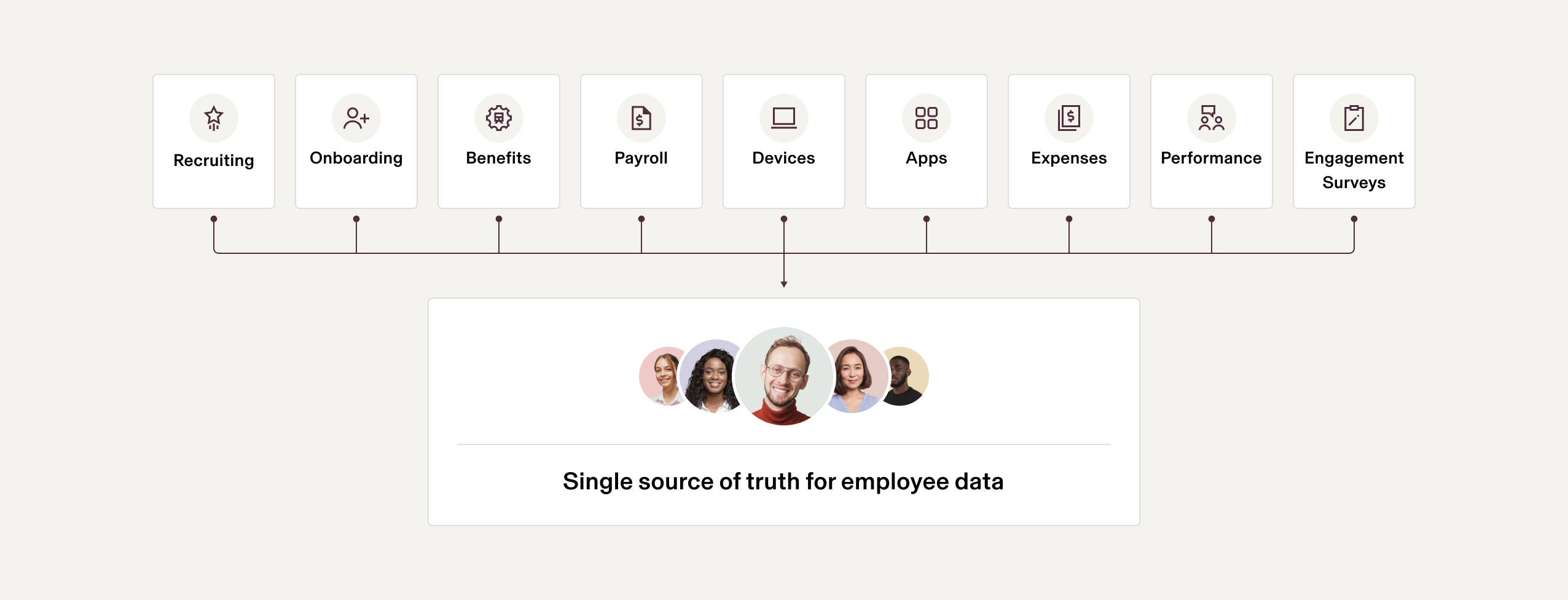HR goals: 16 Examples and strategies to boost success

As we approach 2025, setting actionable HR goals is a must for companies looking to thrive in a competitive landscape. HR leaders are under intense pressure to drive measurable business outcomes and meet lofty goals. Boost employee retention, improve team performance, do more with way, way less!
Despite the pressure, most companies aren’t looking to expand their HR departments in the coming year. HR functions took a huge hit in recent years, accounting for 28% of tech layoffs across major industries. So, how will you lead an overworked, understaffed team in achieving your most ambitious goals yet? You need your HR tech to work harder.
Evaluating your current HR tech stack is essential to ensure your systems actively empower your team rather than hinder progress. Ready to find out how the right tools can safeguard your 2025 HR objectives? Read on to explore HR strategies and solutions to drive success in today’s high-pressure environment.
What are HR goals?
HR goals are specific, strategic objectives that human resources teams set to align their work with the broader business mission. These goals guide human resource management in prioritizing initiatives, tracking performance, and driving meaningful outcomes like improving employee engagement and streamlining onboarding and compliance processes.
HR goals often follow the SMART framework, a widely used method to ensure goals are clear and achievable. SMART stands for Specific, Measurable, Achievable, Relevant, and Time-bound. These are the criteria that HR teams should use to set precise targets and stay accountable. For example, a SMART HR goal could be "to increase employee retention by 10% by the end of Q4 2025." This goal is specific (employee retention), measurable (10% increase), achievable (based on historical data), relevant (supports company growth), and time-bound (by the end of Q4 2025).
Incorporating SMART goals into HR planning can help organizations set realistic expectations and track progress.
The importance of setting HR SMART goals: 4 Benefits
Implementing SMART goals in HR planning can help HR teams stay aligned, motivated, and accountable. Here are some key benefits:
1. Improved focus and performance
SMART goals provide HR teams with a clear, structured path to success. By setting specific, achievable objectives, teams can prioritize their efforts and focus on initiatives that directly contribute to organizational goals. This clarity boosts overall team performance and ensures resources are allocated effectively.
2. Trackable process
With measurable components, SMART goals allow HR leaders to track progress over time. This lets HR teams assess their impact and make data-driven adjustments when needed.
3. Enhanced motivation on the HR team
Clear, time-bound goals inspire greater motivation within HR teams. Knowing exactly what to accomplish and by when can create a sense of purpose and urgency, helping team members stay engaged and driven to reach milestones that contribute to both personal and team success.
4. Improved accountability
SMART goals establish a framework for accountability by defining each goal with precision and a deadline. This structure helps people stay accountable for their tasks, fostering a culture of ownership and responsibility.
HR SMART goals: 5 Examples for your business
When setting HR goals, focus on specific areas to drive success in high-impact areas. Here are some key areas to consider, along with hr goals examples that are aligned with the SMART framework.
1. HR goals for talent acquisition
Talent acquisition is critical to building a skilled, diverse workforce. Setting focused goals in this area helps HR teams streamline their recruitment processes and attract top talent.
Example goals:
- Grow the candidate database by 20% by the end of Q3.
- Integrate two new recruitment analytics tools by mid-2025 to enhance candidate tracking and reporting.
- Increase the percentage of underrepresented candidates in the hiring process to 30% by Q4.
- Reduce the average time-to-hire by 15% over the next six months.
2. HR goals for onboarding
Effective onboarding improves employee retention and satisfaction. HR teams should aim to create smooth, engaging onboarding processes that help new hires feel welcomed and prepared in their new work environment.
Example goals:
- Revamp the onboarding process to reduce time-to-productivity for new hires by 25% within six months.
- Achieve a 90% satisfaction rate in new hire onboarding surveys by the end of the year.
- Develop a digital onboarding handbook by Q2 2025 to standardize onboarding and make key resources easily accessible.
- Implement a mentorship program pairing new hires with existing employees within their first month.
3. HR goals for performance management
Effective performance management systems help align employee efforts with business objectives. Setting goals in this area can improve productivity, motivation, and retention.
Example goals:
- Introduce quarterly feedback sessions for all employees by the end of Q2 to ensure continuous performance improvement.
- Increase participation in performance reviews to 95% within the year.
- Implement a new performance tracking tool by Q3 2025 to provide clearer metrics on employee progress and areas for improvement.
- Conduct manager training to boost the quality of feedback by at least 30%, measured through follow-up surveys.
4. HR goals for compliance and policy updates
HR is responsible for maintaining compliance with labor laws and updating policies to reflect changes in legislation. Achieving goals in this area minimizes risks and supports a safe, fair workplace.
Example Goals:
- Update all employee policies to reflect current labor laws by the end of Q2 2025.
- Conduct quarterly training sessions on compliance topics, aiming for 100% attendance.
- Implement an annual compliance audit by Q4 to identify areas for policy improvement.
- Develop a streamlined system to track and update changes in labor law to ensure full compliance year-round.
5. HR goals for promoting diversity in the workplace
Diversity and inclusion are essential for fostering a positive workplace culture and broadening the perspectives within an organization. Setting goals in this area helps HR teams create a welcoming environment for all.
Example goals:
- Increase the diversity of leadership roles by 15% by the end of 2025.
- Establish an internal diversity committee by Q3 to provide feedback on inclusion efforts.
- Launch two new employee resource groups (ERGs) by Q2 2025 to support underrepresented employees.
- Implement a quarterly diversity survey to measure inclusivity and identify areas for improvement, aiming for an 80% response rate.
The importance of HR tools on HR goal achievement
A quick walk through the 2024 HR Tech Conference revealed a big problem: the HR industry has become oversaturated with an explosion of SaaS solutions. The average organization now invests in 16+ HR systems, often with overlapping functionality.
"All-in-ones" vs. point solutions
Nearly every single company today relies on an HR technology stack consisting of point solutions and “all-in-ones.”
- Point solutions offer deep functionality for the problem they solve, but they operate in a vacuum—ignoring how their individual function fits into the bigger picture of workforce management.
- “All-in-ones” are often legacy providers that were originally designed as point solutions. They set out to give HR a centralized place to solve a variety of use cases, but as they grew, they got clunky. They piled on new functionalities without the proper infrastructure in place. Bottom line: these so-called “all-in-one” solutions are poorly integrated systems, with mismatched data, jumbled under a single logo.
Ultimately, point solutions and “all-in-ones” have the same underlying weakness: they were both designed too narrowly from the start. That has a seismic impact on you, your team, and your company’s overall employee experience.
The consequences of siloed HR systems
Without connected systems, HR teams are forced to spend excessive time on manual tasks, like transferring data between platforms or fixing errors. This reduces the time they can spend on strategic initiatives like employee engagement, talent development, and performance management. Additionally, when data is siloed across different systems, HR teams miss out on actionable insights, making it difficult to track progress and make informed decisions.
To truly achieve HR goals, organizations need integrated HR systems that ensure data flows seamlessly across all functions, enabling teams to focus on strategic work and make data-driven decisions. Investing in tools that work together is essential for improving efficiency and reaching your human resources objectives.
How to set HR goals: 4 Best practices
Setting effective HR goals requires thoughtful planning and strategic alignment. Here are some best practices to guide HR pros in setting goals that drive success:
1. Align HR goals with business objectives
HR goals should be closely linked to the overall business strategy. By understanding the company’s key priorities—whether it’s growth, retention, or diversity—HR teams can set goals that support and drive those broader objectives.
2. Be realistic when setting goals
While it’s important to be ambitious, HR teams should also be practical when setting goals. Ensure that objectives are achievable given available resources, time constraints, and the current state of your HR systems.
3. Develop an action plan
Once goals are set, create a clear action plan outlining the steps necessary to achieve them. Break down larger goals into smaller, manageable tasks with deadlines and responsibilities. This helps keep the team on track and ensures that progress is continuously monitored.
4. Set clear KPIs to measure goal achievement
Establishing Key Performance Indicators (KPIs) is essential for tracking progress and measuring success. Choose specific, measurable metrics that align with your goals, such as employee turnover rates or time-to-hire, and regularly assess performance to ensure you’re on track.
Rippling: Achieve your HR goals effortlessly
Instead of starting with a single use case and then tacking on other solutions as an afterthought, Rippling had a holistic vision from day one: to create a unified workforce management platform with a single source of truth for employee data.
With Rippling's unified workforce management platform, your employee data isn’t tied to one specific app or another; it’s the same across payroll, time and attendance, learning management, performance management, or any of our other human resources, spend, or IT needs.

Powerful automation frees up time for strategic work
With a single source of truth for up-to-the-minute employee data, your team doesn’t have to reenter information across every system when an employee gets promoted or moves to a different state. The second this happens, your software automatically triggers every downstream change in a single flow, from updating PTO policies to granting additional security permissions.

In addition to these automatic downstream updates, Rippling comes stocked with 100+ out-of-the-box workflow automations—on top of the custom automations you can create to streamline your company’s unique processes. Once you eliminate repetitive admin tasks, your HR team is free to focus on solving the hard problems and creating a better experience for your employees.
Robust, real-time reporting fuels strategic decision-making
With a centralized hub of employee data, your reporting capabilities are limitless—and you’re armed with powerful insights to drive decision-making across your organization.
Are you looking to identify which people at your company are the strongest interviewers or the best at hiring candidates who go on to be top performers? With Rippling, you can run a cohesive report that combines your interview feedback data with your performance review data.
As a result, you could ensure your best interviewers are on the panels for the urgent hires your business needs to get right in 2025. With a single source of truth for employee data, HR becomes an invaluable driver in the success of your organization.
HR goals FAQs
How often should HR goals be reviewed and updated?
HR goals should be reviewed and updated at least quarterly to ensure they remain aligned with evolving business objectives and industry trends. Regular reviews allow teams to adjust their HR strategic plans based on new data, feedback, and changes in the workforce or organizational priorities. Annual reviews may be necessary for larger, long-term goals, but frequent check-ins help keep the team on track.
How can HR goals help improve company culture?
HR goals that focus on areas like employee engagement, diversity, and leadership development can directly enhance company culture. By setting goals around inclusivity, work-life balance, or recognition programs, HR helps foster a positive, collaborative environment where employees feel valued.
What are some challenges HR managers face in setting and achieving HR goals?
HR managers can face many challenges like resource constraints, lack of data integration across systems, and balancing strategic objectives with day-to-day operational tasks. Unrealistic expectations and resistance to change from leadership or employees can also impede goal achievement. Additionally, tracking and measuring progress can be difficult if KPIs are not clearly defined or if HR systems aren’t integrated to provide comprehensive data. Overcoming these challenges requires clear communication, the right tools, and continuous alignment with business goals.
This blog is based on information available to Rippling as of November 19, 2024.
Rippling and its affiliates do not provide tax, legal, or accounting advice. This material has been prepared for informational purposes only, and is not intended to provide, and should not be relied on for, tax, legal, or accounting advice. You should consult your own tax, legal, and accounting advisors before engaging in any related activities or transactions.









